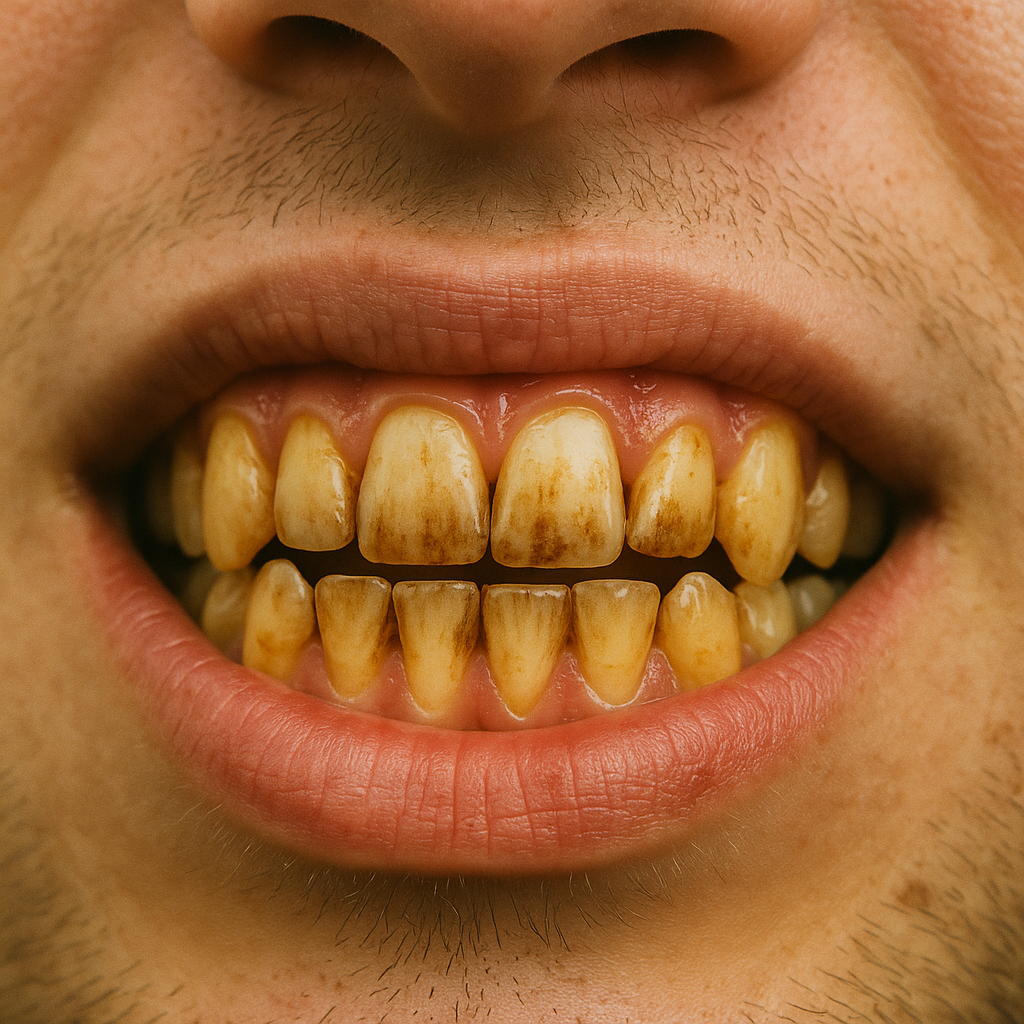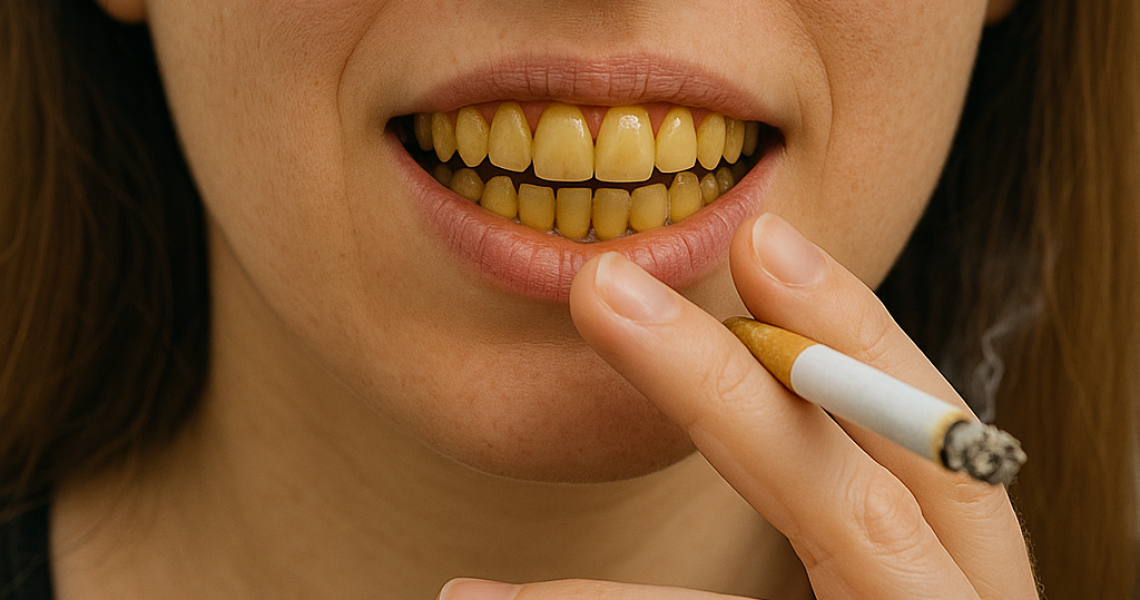Tooth yellowing is one of the most visible side effects of smoking. Not only does it affect the aesthetics of your smile by turning your teeth yellow, but it can also damage your self-confidence. Fortunately, it is possible to reverse some of the damage caused by smoking and regain whiter teeth. In this article, we’ll explore the causes of tooth yellowing, methods to regenerate your smile and the importance of smoking cessation to prevent further damage.

Why do cigarettes turn teeth yellow?
Cigarette smoke contains a combination of chemicals, including nicotine and tar, which cause yellowing of the teeth. These particles stick to tooth enamel and penetrate the pores on the surface, leaving persistent stains that build up over time. Here are the main reasons why smoking affects the yellowing of your smile:
1. Nicotine
Although nicotine is colorless, it turns yellow when exposed to oxygen. It’s this chemical process that contributes to the staining of your teeth.
2. Tar
The tar in cigarettes is a dark, sticky substance that deposits on teeth, leaving brown marks that are difficult to remove.
3. Decreased saliva production
Smoking dries out the mouth, reducing saliva production. Saliva plays an essential role in the natural cleaning of teeth. This reduction in saliva encourages the build-up of plaque and tartar. Gums, often weakened by smoking, are also more vulnerable to disease.
How do you get whiter teeth after quitting smoking?
Once you’ve quit smoking, there are a number of ways to restore your radiant smile. Here are a few key steps:

1. Opt for professional tooth whitening
Tooth whitening treatments at the dentist are the most effective way to remove stains caused by smoking. Techniques such as gel-whitening trays or laser whitening can restore the radiance of your teeth in just a few sessions.
- Benefits: Fast, long-lasting results.
- Cost: These treatments are generally more expensive, but well worth the investment for visibly whiter teeth while preserving your enamel.
2. Use over-the-counter whitening products
Although this solution is less effective than tooth whitening by a dentist, it’s a less expensive way to remove tobacco stains from your teeth, and improve the appearance of your smile. Whitening toothpaste, whitening strips or whitening pens can be used to reduce surface stains. Although they are less powerful than professional treatments, they can complement good oral hygiene. Effects are fairly rapid, and treatment can be carried out independently.
- Tip: Choose products containing hydrogen peroxide, which acts effectively on stains and helps reduce discoloration.
3. Practice rigorous oral hygiene
Good daily care is essential to prevent the appearance of new stains and keep your teeth bright:
- Brush your teeth at least twice a day with fluoride toothpaste. This helps limit the effect of discoloration caused by smoking and drinks such as coffee or tea.
- Use dental floss to remove plaque between teeth and in hard-to-reach areas.
- Follow up with an antiseptic mouthwash to reduce bacteria and improve gum health.
4. See your dentist regularly
Regular professional scaling helps remove plaque and tartar, which contribute to yellowing and discoloration. Personalized advice can also be given to help you improve your eating and oral habits. Far better than whitening toothpaste, a visit to the dentist is essential for the health of your teeth and enamel.
5. Try natural remedies
Some home remedies, such as brushing with baking soda, can help reduce stains. However, these methods must be used with care to avoid damaging enamel and gums. Regular use of bicarbonate can help whiten your teeth, but it’s advisable to use edible bicarbonate and not to overuse it.
Why quitting smoking is essential for a radiant smile
There’s more to brightening up your smile than dental care. For lasting results, it’s essential to stop smoking. The effects of smoking on the discoloration of your teeth and gums are undeniable. Before trying to remedy the effects of cigarettes, and nicotine in particular, on your teeth, it’s essential to eradicate the problem at root. Quitting smoking is the first key to better oral health. Here’s why:
1. Prevent new stains
Quitting smoking prevents the formation of new stains, enabling your teeth whitening efforts to produce long-lasting results. What’s more, reducing consumption of staining beverages such as coffee amplifies this positive effect. It’s also essential to change your eating habits, avoiding foods and beverages that encourage staining.
2. Extend whitening treatment times
The chemicals in cigarettes can quickly undo the effects of whitening treatments. By quitting smoking, you maximize the duration of your results while avoiding excessive discoloration due to old habits.
3. Improve the overall health of your teeth and gums
By eliminating the harmful effects of tobacco, such as tartar build-up and periodontal disease, you contribute to better oral health. Gums become healthier and less prone to disease.
Read also: Open your MyLaserTabac anti-smoking laser franchise and become a laser ear reflexology practitioner
The anti-smoking laser: an effective solution for quitting smoking
For many smokers, quitting can be a real challenge. Fortunately, the anti-smoking laser offers an innovative and effective alternative for freeing oneself from this addiction.
How does the anti-smoking laser work?
The anti-smoking laser is based on auriculotherapy. By stimulating specific points on the ear, it helps reduce withdrawal symptoms such as anxiety and cravings. This facilitates quitting while reducing the impact of smoking on the mouth.
The laser also has a positive effect on general well-being, enabling smokers to break the harmful habits that contribute to discoloration and yellowing of the teeth. This treatment thus promotes better oral health.
The benefits of anti-smoking laser
- Non-invasive and painless
- High success rate: up to 90% of patients experience a significant reduction in their desire to smoke.
- Effective in just one session
- Preservation of teeth and gums: By quitting smoking with the laser, you significantly reduce the onset of dental disease and discoloration associated with smoking.
Patients who have undergone laser treatment report a marked improvement in the color of their teeth. By stopping, they avoid the cumulative effect of staining caused by tobacco and colored drinks. One specialist says: “This treatment is a double win: it helps stop smoking while promoting a brighter smile.”
A comprehensive approach for lasting results
The anti-smoking laser is an ideal part of a comprehensive strategy to restore a radiant smile. By combining this treatment with proper oral hygiene and moderate consumption of staining foods and beverages, results can be amplified. The advice of a specialist dentist also helps to maintain healthy, white teeth.
By using the laser to stop, you’re not only eliminating yellow stains, you’re also helping to whiten your teeth naturally. This treatment gives you another chance to preserve the natural color of your teeth while improving their overall health.
Conclusion
Tobacco-related yellowing of the teeth may seem irreversible, but there are many ways to restore the radiance of your smile. By adopting appropriate treatments, changing your eating habits and quitting smoking, you can not only improve the aesthetics of your teeth, but also their long-term health. Why not start today? Your smile is worth the effort!
